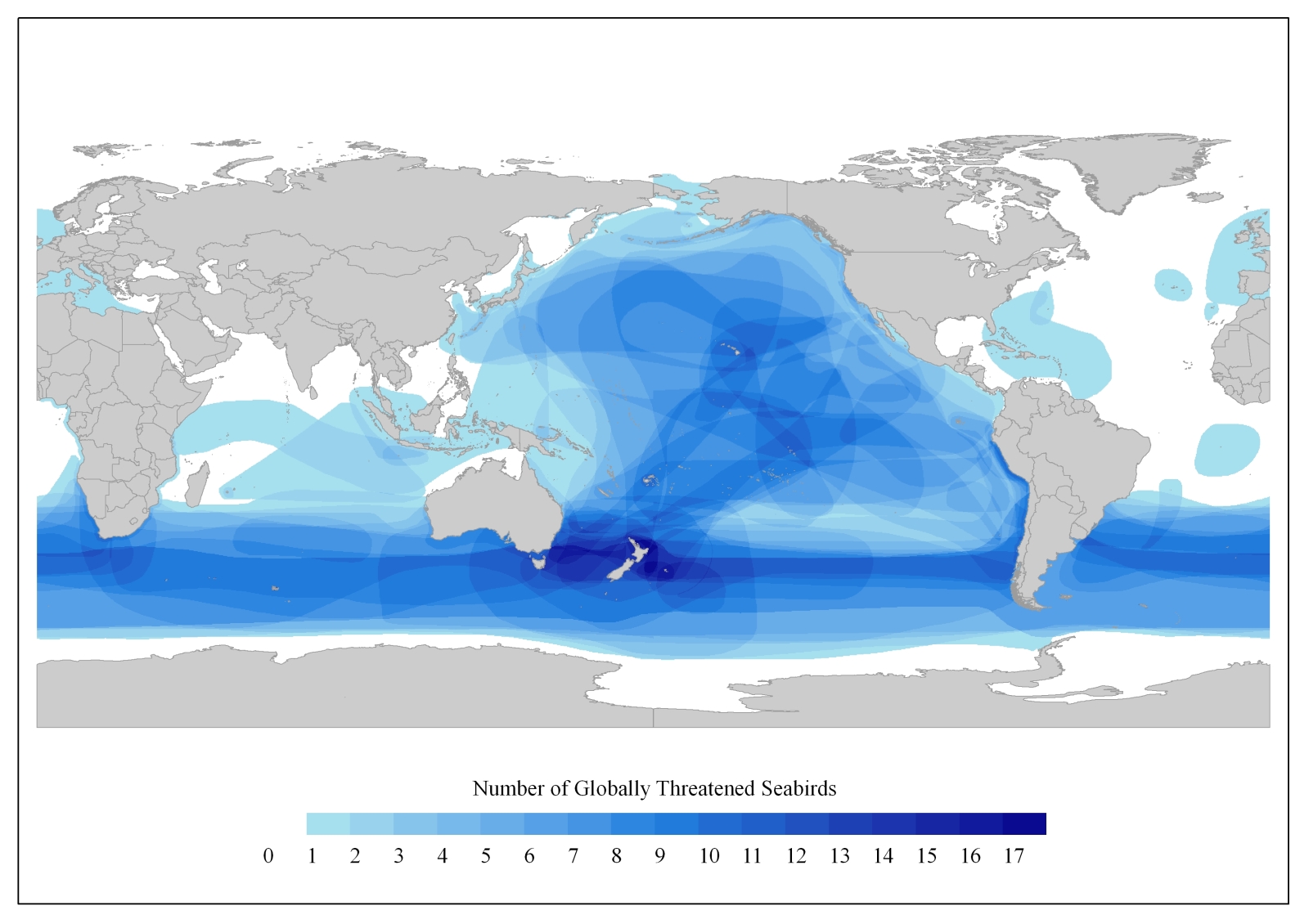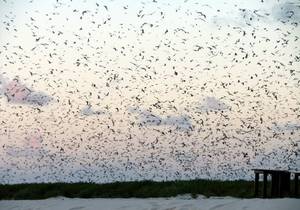Moving Important Bird Areas into the sea
Interview with
Important Bird Areas (or IBAs) form a network of protected sites aimed at safeguarding birds across the globe. For several decades there have been IBAs on land and now Birdlife International is working with partners around the world to extend the network to protect birds that spend some or all of their lives at sea. Ben Lascelles tells us how that process is going, the challenges they face, and just what it is about Important Bird Areas that makes them so important.
Helen - Birds are notoriously mobile. How can a fixed protected area actually contribute to protecting them at a global scale. What sort of things go on inside these areas, presumably this is where they breed, feed, that sort of thing?
Ben - So there's really 4 kinds of site that we feel are suitable for site-based conservation approaches. Those are areas around the breeding colony where birds feed or roost, non-breeding areas where they might congregate in coastal zones, migration bottlenecks and pelagic feeding areas around things like seamounts, upwellings, all that kind of stuff.
Helen - presumably there are an awful lot of marine species that use the ocean for some of part of their life spans. Are we talking 100s of species, 1000s of species?
Ben - We have a list of about 350 species that rely on the marine environment for at least part of the year. Some of those are true seabirds that people think of like penguins and albatrosses, but there are a number of other more coastal species things like terns and cormorants that also might be suitable for this kind of approach.
Helen - And what sort of threats are we talking about?
 Ben - probably the biggest is bycatch, incidental bycatch from fisheries activities, longline fishing is particularly bad for that and can kill hundreds of thousands of sea birds a year.
Ben - probably the biggest is bycatch, incidental bycatch from fisheries activities, longline fishing is particularly bad for that and can kill hundreds of thousands of sea birds a year.
So we really feel these sites can help inform where bycatch management can be used. The work we're doing can also inform other ocean user groups, things like offshore wind farms can be particularly bad for some species, oil and gas exploration, development, management of oil spills, there's a whole range of things that either cause direct mortality to seabirds or have incidental secondary effects.
One of the challenges is to try and convince people there are lots of birds in a particular location now that they'll be there next year or the year after. And for some places that's relatively easy when you've got some sort of static feature like a seamount, but in other cases that's quite hard where you have moving frontal zones or upwelling systems that can be seasonal or vary annually.
Helen - And I've got to assume that by taking on the marine realm you're introducing a whole new set of challenges to doing this kind of approach to conservation. What are some of those things that you've had to deal with?
Ben - one of the biggest challenges is data. The oceans are so vast, that having useful data to analyse to come up with these sites in a consistent and defensible way is quite a challenge. Defining boundaries is very difficult because in terrestrial environments where a forest ends and a road begins is usually pretty obvious. But we don't have that luxury in the marine environment, so basing it on lines of latitude, longitude, bathymetry, that kind of thing, you need to use some slightly different approaches to come up with sites. So I'd say those are the two main challenges.
Helen - and are you going out and taking new data or is the idea to make use of what's already out there?
Ben - well very much to try and pull together what already exists so we can make a good first cut of the sites. And we really rely on 3 or 4 types of data: satellite tracking data being a key one for us, at-sea survey data from boats and planes, and then coastal counts can be useful as well, and there's new advances in things like radar that can be used to identify where birds are and in what numbers.
 Helen - So you've got this idea of gathering data together to find out parts of the oceans that birds use. And the Important Bird Areas are going to become a network, you're looking at establishing a global system for protecting seabirds. Is there are sort of goal in terms of the area you want to cover? How do you decide this is going to do the job we want it to do?
Helen - So you've got this idea of gathering data together to find out parts of the oceans that birds use. And the Important Bird Areas are going to become a network, you're looking at establishing a global system for protecting seabirds. Is there are sort of goal in terms of the area you want to cover? How do you decide this is going to do the job we want it to do?
Ben - I don't think we have an overall percentage that we're aiming for. We're more keen to ensure that sites are located in the right places to protect the right things. So really, we're letting the data tell us where sites should be, how big they should be, so that we can build up some good justification for them and then once we have a complete network for species and regions we should be in a position then to see what percentage overall that is.
Helen - I guess the question then becomes once you've identified this network how do we then go about implementing that and putting in conservation measures. What sort of things can we do to protect these birds?
Ben - One of the keys things we're trying to do having identified sites is link to relevant policy mechanisms, like the CBD (The Convention on Biological Diversity), or relevant regional agreements, things like in the NE Atlantic we have the OSPAR convention, elsewhere in the world we have things like the Nairobi Convention for the Indian Ocean, ASEAN Agreement for SE Asia, and there are a number of others around the world. So we're trying to build the capacity of our Birdlife partners to engage in these kind of agreements and put forward a network of sties that we feel are robust and have lots of support as to why they're important.
And also make the point that seabirds occur in areas used by lots of other marine biodiversity, things like sea mounts, upwellings, continental shelf, all those kind of things, and birds at the top of the food chain you can really use them as indicators of the state of the marine environment more generally.
Helen - And where are we at with this whole process of putting IBAs into the sea? Are the are any that have already been set up or is this something that's about to happen and we'll see it in the coming years?
Ben - The first attempts were probably done getting on for 10 years ago now but really Birdlife has only had a coordinated approach to this for the last 5 or 6 years. So there are now several national inventories of marine IBAs, some of the first were in Alaska, the Baltic, and Iberian Peninsular, Spain and Portugal. And we hope to launch later this year our first global inventory of marine IBAs at the next conference of the parties of the Convention on Biological Diversity in October 2012.
Helen - And are there any examples of a site that you've looked that's jumped out as being obviously a very important sites for birds? Are there any that are spectacular places that you've seen yourself that makes you think, this has got to be protected?
Ben - There are certainly lots of the major currents of the world. The Benguela, the Agulhas, the Humboldt Current, California Current - long recognised as being key places for breeding seabirds and during the non-breeding season.
I've been to the Humboldt a couple of times and done boat trips out there and the scale and the sheer number of birds and right whales and things like that is staggering.
Helen - The only place I've had a similar experience is further North, in California in Monterey. And I did once have a day out at sea where there was one of those bait balls, and there were hundreds and hundreds of dolphins and whales and seabirds and you're in the middle of it all and it's just spectacular.
Ben - I think everyone should try and see that at least once in their lives. It's an amazing event and don't think would leave anyone in any doubt that something has to be done to manage and protect these places in a sustainable way.
Find out more:
Birdlife International,
Global Seabird Programme
Birdlife International,
Marine Important Bird Areas website
Leaflet (PDF)
Marine Important Bird Areas, from Birdlife International










Comments
Add a comment